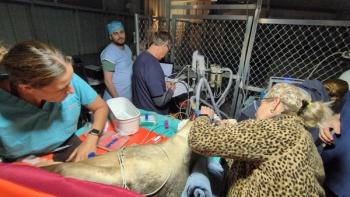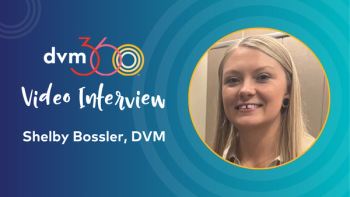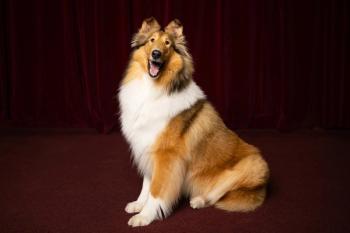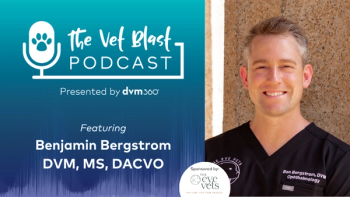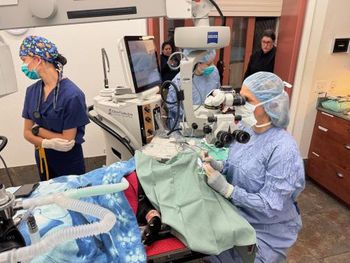
Glaucoma: Early recognition and initial treatment (Proceedings)
Early recognition of glaucoma is essential in managing this disease and preventing the natural outcome, which is a painful and blind eye. Recognition is preceded by having a suspicion for glaucoma, and various signs, including fixed and dilated pupils, engorged episcleral vessels, and a hazy cornea, should heighten this suspicion.
Early recognition of glaucoma is essential in managing this disease and preventing the natural outcome, which is a painful and blind eye. Recognition is preceded by having a suspicion for glaucoma, and various signs, including fixed and dilated pupils, engorged episcleral vessels, and a hazy cornea, should heighten this suspicion. Diagnostic tests can help to verify the diagnosis, and referral of a glaucoma patient should be considered as an option to the owner.
A suspicion of glaucoma is based on the classical signs previously discussed. Certain breeds are highly predisposed, and the most common breeds are the Basset Hound, American Cocker Spaniel, and Chow Chow. Clients who have these breeds as pets should be pre-warned about the risk of glaucoma, and that should be followed up by periodic screening of intraocular pressures.
The minimum database for evaluation of a red, cloudy eye should include Schirmer tear tests, fluorescein dye test, and tonometry. The anterior segment examination is best aided with magnification and bright focal illumination in a dark room. Tonometry involves the estimation of intraocular pressure with various instruments. The Schiotz tonometer is the classic instrument that has been around since the mid-1800s; it works on a principal of indentation. Modern instruments include those of applanation, "Tono-Pen," and rebound, "TonoVet," tonometers. The Schiotz tonometer's principal of indentation is based on the theory that hard eyes will indent very little and soft eyes will indent a lot. The instrument has a footplate fashioned for the curvature of the human cornea. Once the footplate is placed on the cornea, the plunger will indent the globe. Numbers across the top of the dial are correlated to fractions of millimeters of indentation, and these can be correlated with a table to intraocular pressure. The most common applanation tonometer is the Tono-Pen, and it estimates pressure by flattening of the cornea. The most common rebound tonometer, the TonoVet, has a plunger that bounces off the surface of the cornea, and the speed of rebound is associated with intraocular pressure and the theory that a harder surface will rebound quicker. All three instruments have their weaknesses and limitations, and operator skill is essential. Cleaning of the instruments also can affect accuracy.
Glaucoma is often defined as an intraocular pressure that is incompatible with vision. This gives a wide range of pressures as possibilities. In human medicine, is low-pressure glaucoma is recognized. Certain breeds, based on metabolic conditions such as diabetes, may have smaller elevations in intraocular pressure with more exaggerated loss of the optic nerve fibers. Death of the optic nerve fibers is through loss of axoplasmic flow or hypoxia. Our general definition of glaucoma is an intraocular pressure above 25 mmHg. Once initial tonometry has been taken and pressures are recognized, as elevated, immediate medical intervention is essential.
Medical intervention includes the use of osmotic diuretics and various topical and systemic preparations to help reduce the inflow of aqueous humor and expand the outflow. Osmotic diuretics work by dehydration and shrinkage of the vitreous cavity, which creates a larger space in the anterior chamber. By reduction of the fluid volume within the globe, intraocular pressures are lowered. Common osmotic diuretics include mannitol and glycerin. Glycerin is generally dosed at 0.75 mL per pound, and it is essential to follow any osmotic diuretic by withholding water for a minimum of four hours and then slow reintroduction of water over the next four to eight hours. An easy method for the slow reintroduction of water is filling the water bowl with ice cubes, and as the ice cubes melt, the patient can rehydrate slowly.
Often, glaucoma is aggravated by secondary conditions and is triggered by inflammation. Anti-inflammatories, both systemic and topical, are often part of the medical management. Antiglaucoma agents include carbonic anhydrase inhibitors, prostaglandin analogues, and parasympathomimetics, both direct and indirect. Various alphaagonists and beta-blockers are a part of the modern armamentarium for management of glaucoma.
ER management protocol for glaucoma
• Diuretics: Mannitol
Glycerin 0.75 ml / pound
• Xalatan: one drop q 12 hrs
• Azopt: one drop q 12 hrs
• Pred Acetate 1% : one drop q4hrs
• Methazolamide: 1mg / pound
• Repeat pressures at 30 minute intervals for 2 hours
On a referral basis, in addition to having intraocular pressure evaluated, gonioscopy will be performed to aid in planning the most effective therapy.
Often, surgical intervention is necessary for the management of glaucoma. Techniques often employed include cyclocryotherapy, laser photocycloablation, valve implantation, and a variety of combination of the above procedures. The newest procedure employees a technique of endolaser ablation of the ciliary body processes. In our group, the lens is removed at the same time to aid in the process of endolaser, as well as to create a larger anterior chamber space and less pressure on the iridocorneal angle. We will also place an Ahmed valve to help further establish alternative outflow. This aggressive surgical approach is resulting in success rates above 90% at six months.
End-stage glaucoma is often painful and expensive to manage medically. There are a number of procedures to manage the end-stage glaucoma, and although enucleation is always an option, other alternatives include implantation of an intrascleral prosthesis, cryosurgery, and chemical ablation. These techniques will be discussed.
Newsletter
From exam room tips to practice management insights, get trusted veterinary news delivered straight to your inbox—subscribe to dvm360.


